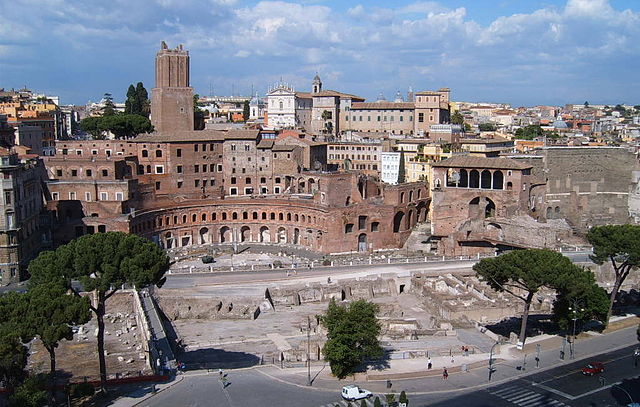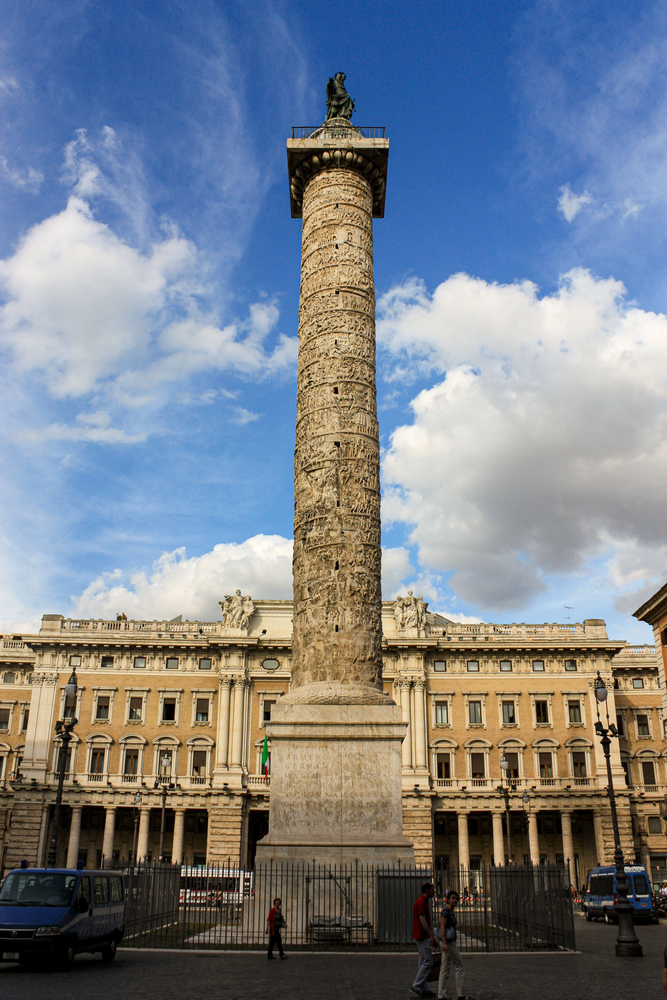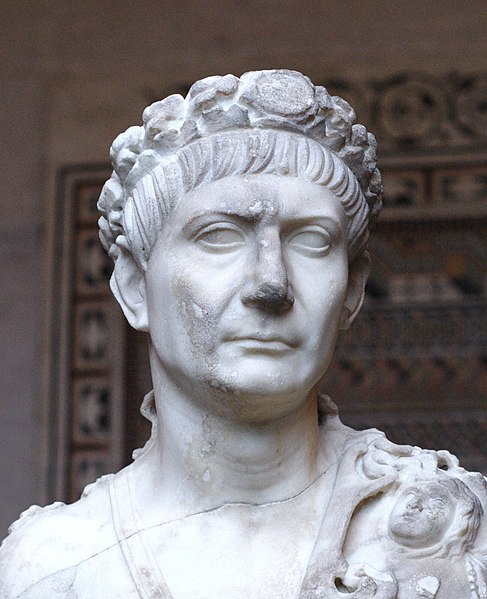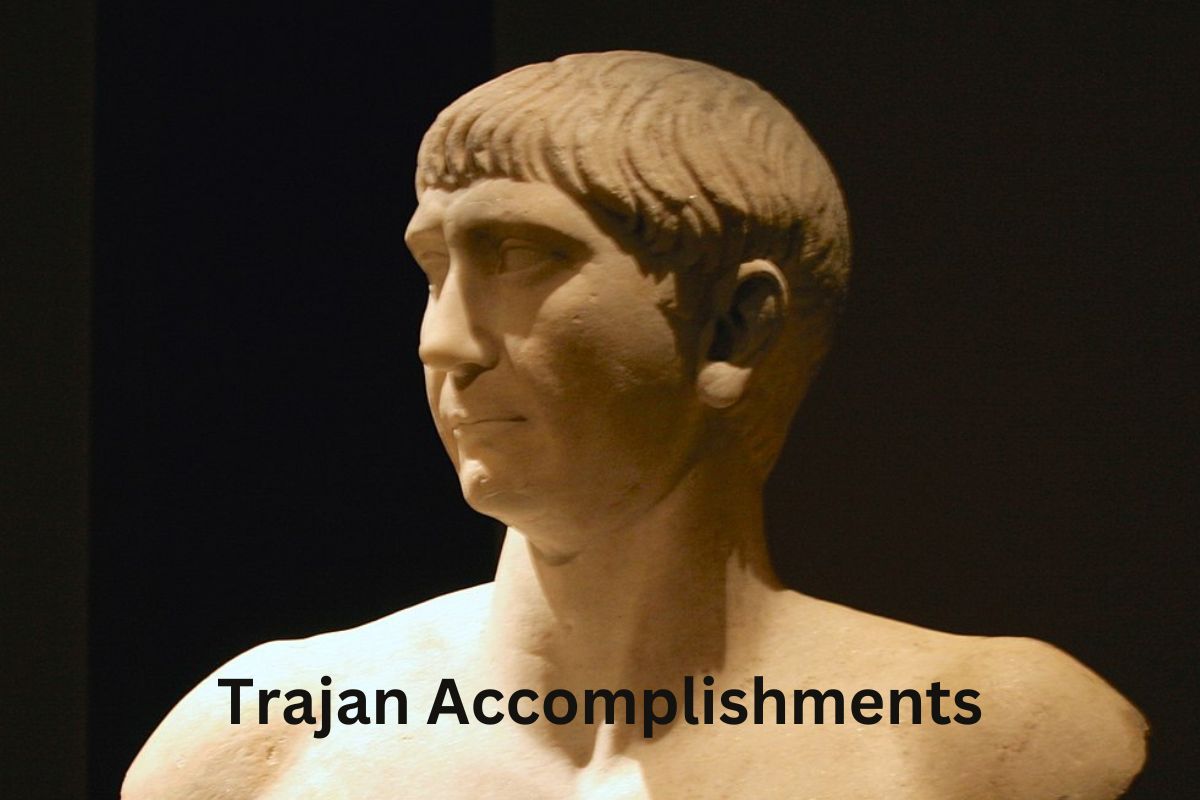Trajan (53-117 AD) was a Roman emperor known for his military conquests, expansive territorial acquisitions, and impressive architectural projects. He implemented social welfare programs, undertook infrastructure development, and codified Roman law. Trajan’s reign is considered one of Rome’s most successful and influential periods.
Born in Italica, Spain, Trajan rose through the ranks of the Roman military, displaying exceptional leadership and strategic prowess.
Trajan’s leadership and accomplishments earned him widespread admiration from the Senate and the Roman populace. He passed away in 117 AD, leaving a lasting legacy as one of Rome’s greatest emperors.
Trajan’s reign continues to be revered as a period of prosperity, military success, urban development, and cultural flourishing in Roman history.
Accomplishments of Trajan
1. Construction of Trajan’s Forum

Trajan’s Forum was a massive architectural complex built in Rome during Trajan’s reign as emperor from 98 to 117 AD. It was an ambitious project that aimed to provide a grand civic center for administrative, commercial, and cultural activities.
Also Read: Facts About Trajan
The forum consisted of several buildings, including a basilica, markets, and administrative offices. It served as a bustling hub of social and economic life in ancient Rome, showcasing Trajan’s vision for urban planning and public spaces.
2. Expansion of the Roman Empire
One of Trajan’s most significant accomplishments was his successful military campaigns that resulted in the expansion of the Roman Empire to its largest territorial extent. His conquests were focused primarily in the east, where he led his legions to victory over various regions.
Notably, Trajan’s forces conquered the kingdom of Dacia (modern-day Romania), incorporating it as a new province. He also achieved significant successes against Parthia, capturing key cities like Seleucia and Babylon. The expansion of the empire under Trajan’s rule brought wealth, resources, and increased influence to Rome.
3. Construction of Trajan’s Column
Trajan’s Column is an iconic monument located in Rome that was constructed to commemorate Trajan’s military victories.
The column stands at around 98 feet (30 meters) tall and consists of a spiraling relief frieze that wraps around its exterior. The relief depicts scenes from Trajan’s campaigns, including battles, sieges, and triumphal processions.
The column served both as a monument to Trajan’s military achievements and as a propaganda tool to celebrate Rome’s military might. Its intricate artistic details and engineering prowess make it a remarkable symbol of Roman art and architecture.

4. Completion of Trajan’s Market
Trajan’s Market was an extensive complex of buildings located next to Trajan’s Forum in Rome. It is considered the earliest known example of a shopping mall. The market consisted of a series of multi-level structures that housed a variety of shops, offices, and even residential spaces.
It served as a centralized hub for commercial activities, offering a wide range of goods and services to the people of Rome.
The completion of Trajan’s Market not only provided a vibrant commercial center but also showcased Trajan’s commitment to urban planning, organization, and creating spaces that catered to the needs of the population.
5. Welfare Reforms
Trajan implemented several social and welfare reforms during his reign, aimed at improving the lives of Roman citizens, particularly the most vulnerable. One notable reform was the expansion of the alimenta system, a program that provided financial assistance and support to impoverished children.
Through the alimenta system, orphaned or underprivileged children received financial aid, including regular allowances and even education. This initiative aimed to ensure that every child in the empire had access to basic necessities and opportunities for a better future.
Trajan’s welfare reforms reflected his concern for the well-being of the less fortunate and his desire to address social inequality within the empire.
6. Infrastructure development
Trajan prioritized infrastructure development throughout the Roman Empire. He undertook ambitious projects to construct and improve roads, bridges, aqueducts, and ports.
The construction of roads facilitated the movement of troops, goods, and information across the vast territories of the empire, enhancing trade, communication, and administrative efficiency.
Bridges and aqueducts provided vital transportation and water supply networks to cities and towns. Additionally, Trajan invested in port facilities, such as the expansion of the port of Ostia near Rome, to bolster maritime trade and ensure the smooth functioning of the empire’s maritime connections.
Trajan’s infrastructure development initiatives contributed to the stability, prosperity, and interconnectedness of the Roman Empire.

7. Legal Reforms
Trajan implemented significant legal reforms during his reign to ensure fair and just governance within the Roman Empire. He appointed jurists to codify and clarify Roman law, leading to the creation of the Digest of Roman Law, known as the “Pandects.”
The Digest compiled and organized legal principles and rulings, providing a comprehensive and accessible resource for legal practitioners and citizens alike. This codification of Roman law improved legal consistency and predictability, strengthening the legal system and promoting fairness in the administration of justice.
Trajan’s legal reforms contributed to the stability and effectiveness of Roman law, setting a foundation for legal principles that endured for centuries.
8. Public Building Programs
Trajan sponsored the construction of numerous public buildings throughout the Roman Empire. These projects aimed to enhance the quality of life for Roman citizens and demonstrate the grandeur of imperial power. Public buildings included libraries, bathhouses, theaters, and amphitheaters.
Libraries preserved and disseminated knowledge, while bathhouses provided communal spaces for hygiene and relaxation. Theaters and amphitheaters offered venues for entertainment and cultural events.
These public building programs not only provided practical benefits but also served as symbols of civic pride and imperial grandeur. They showcased Trajan’s commitment to urban development, cultural enrichment, and the promotion of public welfare.
9. Patronage of the Arts
Trajan was known for his patronage of the arts and his support for cultural endeavors. He commissioned numerous sculptures, monuments, and architectural projects that celebrated his reign and the glory of Rome.
Artists, architects, and craftsmen were given opportunities to showcase their skills and contribute to the beautification of the empire. Trajan’s patronage extended to literature and intellectual pursuits, fostering an environment conducive to literary and scholarly activities.
By promoting the arts, Trajan contributed to the flourishing of artistic expression, cultural achievements, and intellectual endeavors during his reign.
10. Public Welfare Projects
Trajan undertook various public welfare projects aimed at improving the well-being of Roman citizens. These initiatives included the construction of public baths, the distribution of free or subsidized grain to the population, and the expansion of public spaces for recreational activities. Public baths provided opportunities for cleanliness, social interaction, and relaxation.
The distribution of grain ensured food security and helped alleviate hunger and poverty among the urban populace. The expansion of public spaces, such as parks and gardens, created recreational areas for the enjoyment and well-being of the people.
Trajan’s public welfare projects reflected his concern for the welfare and happiness of the citizens, striving to improve their living conditions and overall quality of life.
